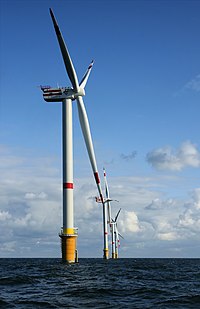
Photo from wikipedia
Abstract The application of thermographic flow visualization on wind turbines in operation differs from the well-established application in wind tunnel experiments. The necessary temperature difference between the rotor blade and… Click to show full abstract
Abstract The application of thermographic flow visualization on wind turbines in operation differs from the well-established application in wind tunnel experiments. The necessary temperature difference between the rotor blade and the flow only relies on the absorbed solar radiation, which often leads to a low signal-to-noise ratio. Furthermore, a large distance of up to 400 m exists between the rotor blade and the thermographic camera for ground based measurements, mainly due to the height of the wind turbine. This results in a poor spatial resolution as well as a small numerical aperture, which means a small detectable radiant power further degrades the signal-to-noise ratio. In order to determine the limits of measurability for the localization of the laminar-turbulent transition, the fundamental effects on the measurement uncertainty are investigated. For this purpose, the measurement uncertainty budgets for three signal processing algorithms are derived and validated with wind tunnel experiments and field measurements on a 1.5 MW wind turbine under sunny and cloudy weather conditions. As a result, the achievable standard uncertainty of the laminar-turbulent transition position for a temperature difference of 2 K amounts to 0.16 pixels in this case, which corresponds to 0.17% chord length. In addition, the measurement uncertainty is currently not limited by the measurement system (detector noise and fixed pattern noise of the camera), but by flow induced temperature fluctuations and fluctuations of the laminar-turbulent transition position itself. Hence, the field measurements on wind turbines in operation are still limited by the flow characteristics, i.e., the measurement object itself. Finally, one of the presented signal processing methods allows a robust, automated flow characterization for wind turbines in operation with subpixel accuracy in all of the presented measurements.
Journal Title: Experimental Thermal and Fluid Science
Year Published: 2018
Link to full text (if available)
Share on Social Media: Sign Up to like & get
recommendations!